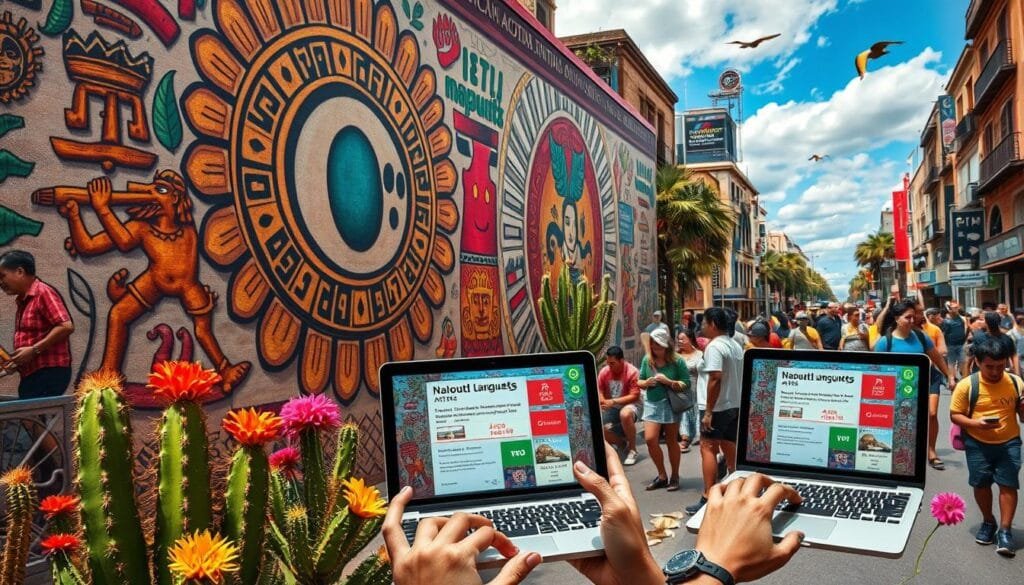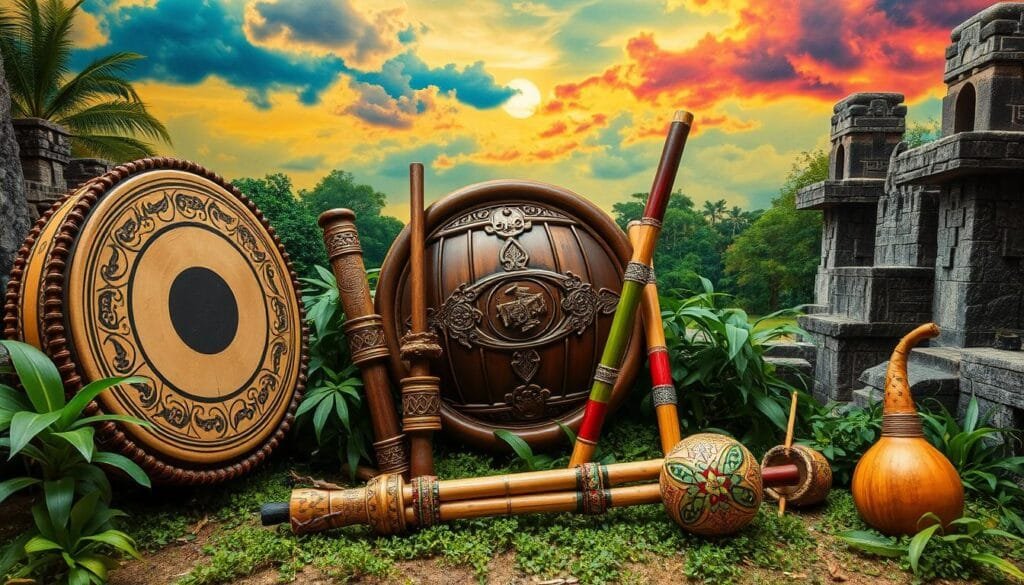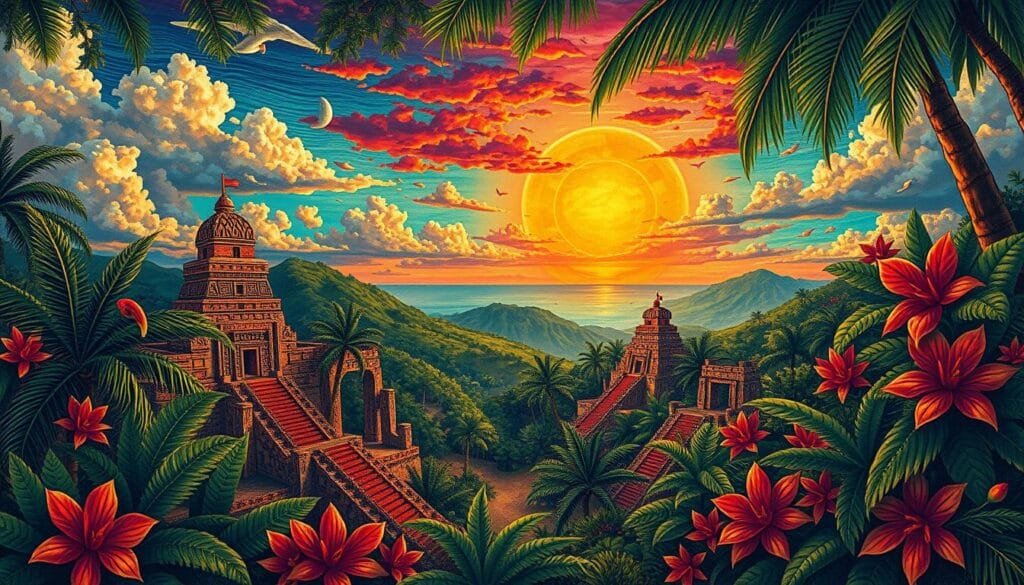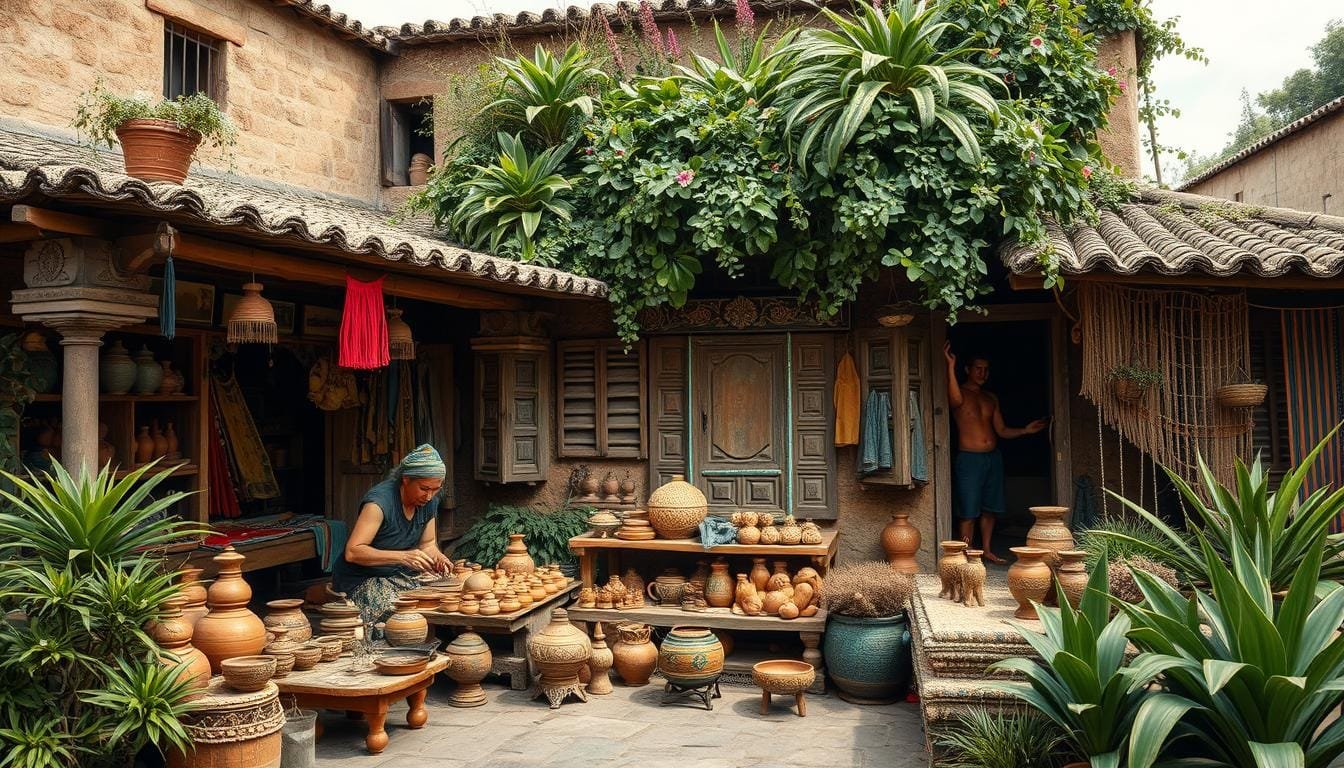What if understanding a nearly lost language is the key to keeping a fascinating civilization alive?
The story of Aztec culture is rich and varied. It takes us from the bustling markets of Tenochtitlan to sacred rituals. The need to preserve this heritage has never been more important. Tenochtitlan, a mega-city of its time around 1450, influences us still. Foods like corn tortillas, hot chocolate, and words like “chocolate” and “tomato” come from the Aztecs.
The Aztec Empire shined for about 200 years, ruling over six million people. Its legacy is seen in today’s practices and inventions, like the ingenious chinampas. Despite the fall of Tenochtitlan in 1521 to Hernán Cortés, which cost around 240,000 lives, many Aztec traditions live on.
To truly keep Aztec culture alive, we must go beyond Spanish narratives and embrace Nahuatl, the Aztecs’ language. This helps us see their world through their eyes. Studying Nahuatl reveals Aztec civilization’s richness, from their complex calendars to cocoa beans as money.
This article shows how to blend ancient Aztec customs into our lives today. We’ll see how language, music, art, and spirituality connect us with the past. This ensures Aztec culture remains vibrant in our world.
For more on how Nahuatl shed light on Aztec heritage, check this study.
Key Takeaways
- Studying Nahuatl is key for a true understanding of Aztec culture.
- Aztec heritage lives on in our food and language today.
- Chinampas, ancient Aztec farming, is still practiced.
- Looking at Indigenous views corrects old Spanish misconceptions.
- The influence of the Aztec Empire is seen in lasting traditions and findings.
The Importance of Preserving Aztec Culture
Understanding Aztec history and its impact today is essential for us. The Aztec civilization was advanced and greatly influential. It stretched over 80,000 square miles in central Mexico. By 1519, the Aztec capital had more than 200,000 people. This was more than any European city at the time.
The city flourished because of smart farming methods like the chinampa system. This allowed them to produce lots of food. Aztec culture included more than farming. It had unique social systems, rituals, and arts. This gives us a full picture of their life.
Understanding the Historical Context
The Aztec Empire was famous for its grand buildings, religious ceremonies, and military tactics. Under Moctezuma II, from 1502 to 1520, they even punished wasting resources. This shows they were eco-conscious. Their warriors were highly respected, using weapons like the macuahuitl club. It had sharp blades and was terrifying on the battlefield.
By honoring these aspects today, we honor the Aztecs’ contribution to Mexican history. They had a complex government and a system for paying tribute. This shows us how sophisticated their society was.
The Role of Descendants in Cultural Preservation
Today, Mexica descendants are crucial in keeping Aztec culture alive. They choose to identify as Mexica, not Aztecs. They work hard to maintain their rich traditions. They share their heritage in public talks, modern media, and traditional events. Aztec symbols and rituals are seen in celebrations like Día de Los Muertos. This connects us authentically to their past.
Mexica descendants are key to preserving Aztec insights. They involve the youth through education and community events. This builds respect and knowledge of their ancestors. It links our past and present, making preserving culture important for everyone.
Reviving Aztec Language: Nahuatl in Modern Media
Today, the Nahuatl language is making a comeback through modern media. Thanks to social media and YouTube, this ancient tongue is finding new life. These platforms have become key in reviving indigenous languages.

Nahuatl on Social Media and YouTube
Platforms like social media and YouTube are bustling with Nahuatl content. Around 1.5 million Mexicans still speak it today. These platforms allow them to connect and share their language.
Influencers and educators are also jumping in. They use YouTube to offer lessons, share stories, and celebrate Nahuatl culture. This helps keep the language alive and well.
Educational Programs and Language Classes
There are now educational programs dedicated to Nahuatl. For example, the University of Utah teaches it regularly. Harvard also has a study group of about a dozen eager learners.
But challenges in keeping indigenous languages like Nahuatl alive remain. Problems with passing the language on and documenting it persist.
| Institution | Location | Number of Students |
|---|---|---|
| University of Utah | Salt Lake City, Utah | Regular Classes |
| Harvard Study Group | Cambridge, Massachusetts | Approx. 12 Students |
| New York City Class | New York, New York | Approx. 7 Students |
Importance of Language in Cultural Identity
Nahuatl’s revival is about more than just words. It breathes life into cultural identity. This language carries the legacy of the Aztecs since the seventh century.
It’s a vessel for history, knowledge, and pride. Recognizing the link between language and culture is vital. It helps keep the community’s heritage and future alive.
Traditional Aztec Music and Instruments
Aztec music reveals a world of unique sounds and instruments, essential to their culture. Traditional Aztec instruments were key in daily life and large ceremonies.
Teponaztli and Huehuetl: Key Instruments
The teponaztli and huehuetl drums were not just musical tools; they held sacred roles. Viewed as the homes of two ancient gods, their making involved precious materials. These included fine woods, gold, and shells. The teponaztli drum made deep sounds, and the huehuetl drum had higher tones.
Nobles often had their own musicians, showing how important Aztec music was to them.

The Role of Music in Aztec Rituals and Ceremonies
Aztecs held music-filled rituals every 20 days, involving priests and musicians. “Cantares,” or ghost songs, were sung in battles. These helped warriors enter trance states. Flutes and bead-filled rattles added to the music’s richness during these events.
Music played a crucial role in battles and spiritual practices. Instruments were seen as divine voices. There were performances in temples, demonstrating music’s importance in Aztec society.
Modern Interpretations and Performances
There’s a growing interest in Aztec music today. Artists blend traditional Aztec instruments with modern sounds. Their work captures ancient melodies in new ways.
These performances use poetic imagery like ancient Aztec songs. They highlight the music’s lasting cultural significance. This helps educate and inspire others about Aztec music.
| Instrument | Description | Historical Role |
|---|---|---|
| Teponaztli | Horizontal drum made from wood, producing deep tones | Used in both ceremonial and battle contexts |
| Huehuetl | Vertical drum creating sharp, high sounds | Integral to religious and cultural rituals |
| Huilacapitztli | Flute producing melodic lines | Enhanced the lyrical aspect of ceremonies |
Aztec Art: From Ancient Glyphs to Modern Inspiration
Aztec art is making a big impact on today’s art scene. It mixes ancient glyphs with modern inspiration beautifully. The influence is strong, with its bold shapes, bright colors, and special symbols.
A 2014 study found that 60% of global modern interior designs have Aztec art’s touch. Aztec patterns are big in textiles, furniture, and decor. In the US, 35% of architects and designers prefer using Aztec art themes in their projects.

Homeowners today enjoy mixing old design elements with new ones. A report shows that over 50% of homeowners like using Aztec motifs in their decor. This trend makes homes look unique and honors a rich cultural history.
Aztec art is known for its bold shapes and bright colors in furniture and decor. Take, for example, the ‘Venice Aztec’ wallpaper from Anthropologie. It shows how Aztec art keeps influencing modern style with designs of nature and geometry.
The beauty of Aztec-inspired decor is that it makes spaces look classy and celebrates historical art.
Adding Aztec patterns at home is not just about looks. It also starts conversations on being respectful to cultures. Some worry about cultural appropriation, while others think it honors Aztec history in our global world.
The Aztecs have left a lasting mark with their art. From the ancient glyphs on temple walls to modern designs in homes, their art is still much-loved. Its long-lasting appeal proves that Aztec art will always inspire us.
How is Aztec Culture Still Present in Contemporary Celebrations
Aztec culture still shines in today’s festivities, mixing ancient customs with modern ways. These events help keep history alive and strengthen cultural identity.
Día de Los Muertos and Its Aztec Roots
The Día de Los Muertos is a colorful Mexican event, inspired by Aztec death traditions. With a realm of five to six million people, the Aztecs held grand ceremonies for the deceased. They believed the journey after death took four years, a concept mirrored in today’s rituals.
This holiday is celebrated on November 1st and 2nd. It pays tribute to the dead with altars featuring marigolds, candles, and food. These traditions come from Aztec festivals aimed at helping souls in their afterlife paths. They used to honor the dead with offerings, a practice dating back to the xiuhpohualli calendar.
Integration of Aztec Symbols in Festivals
Aztec symbols show up in celebrations beyond Mexico. In the Zongolica mountains, the Nahua people blend pre-Hispanic and Catholic rituals, keeping Aztec traditions alive. During Día de Los Muertos, skeletons and sugar skulls display ancient beliefs about death and afterlife.
This mix of cultures is evident in All Saints’ Day too, which matches the Aztec Quecholli. It shows how old Aztec customs have been kept and changed over time. Around 80% of Mexicans see Día de Los Muertos as a crucial part of their culture. This highlights Aztec influences in today’s society.
| Aspects | Aztec Influence | Modern Celebrations |
|---|---|---|
| Death Rituals | Journey to Mictlān, offerings for the deceased | Día de Los Muertos, altars with offerings |
| Symbols | Skeletal imagery, marigolds | Skeleton decorations, sugar skulls |
| Calendars | Xiuhpohualli, 365-day year | Día de Los Muertos celebration dates |
| Community Practices | Burial in family grounds, socio-economic status-linked rituals | Nahua community rituals, national observances |
Bringing Aztec symbols into modern parties shows how important this ancient culture is even now. Even as times change, these symbols link us to our history. They deepen how we know and cherish our shared past.
Modern Adaptations of Aztec Spiritual Practices
Aztec spirituality is experiencing a resurgence in today’s world. People are weaving ancient traditions into modern spiritual practices. This blend keeps the Aztec spiritual legacy alive and well. Participants now take part in time-honored ceremonies, using sacred items like peyote and copal incense.
This cultural mix is most noticeable in how traditional Aztec ceremonies merge with today’s spiritual practices. Efforts to rejuvenate Aztec spirituality often involve combining old rituals with new beliefs. This shows the value of linking with our past while adapting to today’s world.
Aztec spirituality’s influence extends into modern art. Mexican artists use Aztec symbols in their creations, showcasing the ancient culture’s lasting impact. Through their art, they not only keep but also honor the spirit of Aztec spirituality in today’s world.
Looking at how these adaptations come to life reveals several key points:
| Ancient Practice | Modern Adaptation |
|---|---|
| Human Sacrifice | Symbolic offerings and community rituals |
| Use of Sacred Plants | Peyote and copal incense in rituals |
| Temple Ceremonies | Annual gatherings at historical sites |
| Worship of Gods like Huitzilopochtli and Tlaloc | Honor through art and dance |
The vibrant adaptation of these ancient practices helps more people appreciate indigenous heritage. Places like Templo Mayor draw numerous visitors, underlining their importance. By presenting these practices in modern times, Aztec spirituality remains a lively and important tradition today.
Conclusion
The Aztec legacy lives on in modern Mexican culture in many fascinating ways. Ancient farming methods like chinampas are making a comeback in places like Xochimilco. Learn more about it here. Traditional music, art, and spiritual practices are also preserved, honoring ancestral wisdom and supporting cultural heritage.
Education, media, and conversations help keep the Aztec spirit vibrant. The Nahuatl language is coming back through social media, schools, and is now officially recognized. Stories from authors like Octavio Paz and Laura Esquivel weave Aztec themes into literature, enriching modern culture.
The Aztec heritage influences us in many ways as we deal with today’s world. It teaches us about the depth of our history and its role in our identity. Aztec symbols in festivals, ancient farming practices, and traditional healing methods are part of our evolving culture. They help keep the Aztec culture alive and inspiring for everyone.
FAQ
What are some modern efforts to preserve Aztec culture?
Today, we see cultural festivals, educational programs, and media showcasing Aztec traditions. Descendants, known as Mexica, are at the forefront. They bring traditions to life by joining public discussions and sharing their heritage.
How does understanding the historical context help in cultural preservation?
Knowing the history of the Aztec civilization is crucial. It helps us appreciate their rich heritage. This understanding encourages preservation efforts across education, media, and community events.
Why do Mexica descendants prefer this term over Aztecs?
Mexica descendants choose this term to honor their true identity. “Aztec” comes from Europeans, but “Mexica” connects them to their indigenous roots. It reflects their genuine cultural heritage.
How is the Nahuatl language being preserved today?
Nahuatl, the Aztec language, thrives on social media and YouTube. It’s also taught in schools. These steps are vital for reviving this language and keeping Mexica culture alive.
What role does language play in cultural identity?
Language is key to expressing and keeping cultural identity. It passes down traditions and values. So, reviving Nahuatl helps maintain Mexica’s cultural heritage for future generations.
What are some traditional Aztec musical instruments?
The Teponaztli and Huehuetl were central to Aztec music, used in sacred and royal events. They show the deep spiritual and social connections in Aztec culture.
How is traditional Aztec music being interpreted today?
Today’s Aztec music mixes ancient sounds with new styles. This keeps the tradition alive, making it relevant for today and beyond.
How do Aztec symbols feature in modern celebrations?
Aztec symbols shine in today’s festivals, like Día de Los Muertos. They remind us of the Aztec’s lasting impact and cultural wealth.
What are the roots of Día de Los Muertos in Aztec culture?
Día de Los Muertos celebrates life and death, a view deeply rooted in Aztec culture. It uses Aztec symbols and practices to honor the dead.
How have Aztec spiritual practices evolved in contemporary times?
Aztec spiritual rituals have adapted to modern times. This keeps them relevant and meaningful, continuing Aztec spiritual traditions today.
